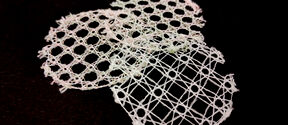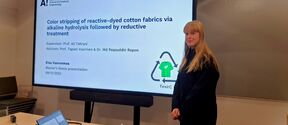Nanostructures can now be '3D printed’ using DNA

Researchers from Aalto University and Karolinska Institutet in Stockholm have developed a method by means of which DNA can be folded to three-dimensional structures of virtually any shape. The method can be compared to nano-scale 3D printing.
The point of departure of the computational design method developed at the Aalto University Department of Computer Science is a mesh model of the targeted three-dimensional structure, the kinds of which are used in computer graphics and industrial design. The method makes it possible to represent the input model as DNA sequences that combine into the desired structure in a saline solution using the ‘DNA origami’ technique. Tests carried out in saline solutions of varying concentrations confirm that the designed DNA strands hybridise into the desired shapes even in saline solutions matching the natural low salt concentration of the body. The result has recently been published in the science journal Nature.
‘An advantage of the design method we have developed is that we were able to make the process entirely automatic to create even complex structures. Previous approaches to the generation of three-dimensional DNA structures have been based on manual work, and the structures created have been quite simple. I believe that advanced computing methods will be of major significance for the development of DNA nanotechnology when steps are taken to proceed from the scale of laboratory tests towards groundbreaking applications,’ says Professor Pekka Orponen from Aalto University.
The new method makes it possible to synthesise three-dimensional DNA structures of virtually any shape. The technology is of immediate use to basic research in cell biology and, in the more distant future, to the development of smart drugs, for example, and of biosensor molecules with applications in monitoring the condition of the body or the environment.
‘For biological use, we need structures that fold in and retain their shape not only in a laboratory setting but also in physiological saline solutions. The new synthesis and design method also makes more effective use of the DNA material than the previous approaches, making it possible to synthesise increasingly complex structures,’ says leader of the study, Professor Björn Högberg from Karolinska Institutet.
The structures generated using the method are 20 to 100 nanometres (one-millionth of a millimetre) in diameter. By way of comparison, the human hair is around 50,000 nanometres in diameter. Using the new technology, the researchers constructed a nano-sized sphere, rod, helical spiral and bottle, for example, and a DNA-printed version of the Stanford Bunny model, a test structure frequently used in 3D modelling.
To carry out the computation, the team at the Department of Computer Science utilised the computer capacity of the Triton computing cluster of the Aalto University School of Science.
For more information:
Professori Pekka Orponen
pekka.orponen@aalto.fi
puh. 0500 819491
Department of Computer Science
Aalto University Scool of Science
Read more news

Learning Centre opening hours during Christmas and year-end holidays
Thank you for the past year and have a wonderful holiday season!
Smart textiles are reshaping our understanding of materials – and interspecies communication
The PAST-A-BOT research project, funded by the European Research Council (ERC), is developing soft, intelligent textiles that could one day function as rescue robots, sound-sensing agricultural fabrics, or assistive clothing. At the same time, the project aims to rethink the way we approach materials research.
Master’s student showcases efficient color stripping of cotton fabrics
On December 9, master’s thesis student Elsa Vuorenmaa from the Textile Chemistry Group presented the results of her research on color stripping of reactive-dyed cotton fabrics.






